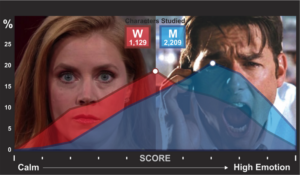Emmys Confirm what AI Reveals about Women on Film and TV Screens.
Posted: September 18, 2017 | Updated: April 24, 2023
Posted In: Articles, Award-Winning Movies
A deep dive into scripts shows the status quo is tough to change.
The 2017 Emmy Awards, with the most diverse gathering of nominees and winners up to that point in history proved one thing: The industry still has a long way to go. But there’s progress.
Nicole Kidman was the Emmy winner for Best Actress, Limited Series, in Big Little Lies. Both she and actress Reese Witherspoon had starring roles and were also executive producers in the show. As Ms. Kidman said when accepting the show’s award for Best Limited Series: “This is a friendship that created opportunities out of our frustration, because we weren’t getting offered great roles.”
At StoryFit we’ve been studying gender-based character personality through Artificial Intelligence (AI) script analysis.
In recent years, television shows featured an unprecedented array of talented women, both onscreen and behind the scenes. Female producers, writers, actors and directors were rightly honored. But changing the course of an entire industry doesn’t happen in just a year. Nicole Kidman continued: “So now? More great roles for women!” (she also said “please.”)
The conversation about gender inequality on screen has been going on for a while. We’re no longer surprised when reports demonstrate, with hard numbers, that female lead characters are fewer than male lead characters; that female characters, whether lead, supporting, or extra, have a cumulatively smaller (much smaller) percentage of dialogue than male characters.
Female Characters in 2D
But beneath those numbers, there’s a wellspring of information: details about the kinds of characters, relationships, and plots audiences really want to see on screen. The details are in the data that we analyze from scripts themselves.
A year ago we started looking into that data at StoryFit. Here’s one thing we discovered: Women exhibit a far more limited range of emotions than men. Of the five major ones, women display either joy or sadness, with not much in between. At least that is how Hollywood is portraying the vast majority of women on screen.
Surprised? I certainly was. In my life, I see a wide emotional spectrum displayed by women. But this isn’t real life; this is the movies. And movies and television can tell us more than we realize about what we actually want to see in plots and characters. The surprising finding, alongside a host of other surprises, is confirmation of what we all seem to know but can’t seem to change in the film industry: for example, the dearth of significant female or non-white characters in the Hollywood product. Insights like the one above come from analyzing and comparing thousands of successful shooting scripts as well as failures.
Here’s a visual representation of that particular data set:

In the study, female characters displayed a shallower emotional range, on average. Male characters in the study exhibited deeper and stronger emotions.
StoryFit™ technology employs AI (Artificial Intelligence) and NLP (Natural Language Processing) to examine the deep data inside these screenplays. From blockbusters to flops, spanning the years 1928 to 2017, they hold information about character qualities, plot and actions to paint a detailed picture of audience preferences.
Advances in NLP, machine learning and AI enable StoryFit™ to “read” a film script and analyze it across many parameters. Multiply that process by more than a thousand, and strong patterns emerge.
Get Happy
For example, when it comes to personality traits, female characters cluster at one or the other end of a scale; they’re extremely agreeable, say, while their male counterparts tend to exhibit a more realistic range of agreeableness.
Look at this chart:

Male characters we studied weren’t always so agreeable. Female characters in the study were very, very agreeable.
Dizzy Dames and Executive Heroes
Other personality traits show differences between male and female characters: examination of the “conscientiousness” trait reveals that female characters are more likely to be messy and disorganized, while male characters are more likely to be type-A planners and day-savers.

Would you hire these female characters to manage your investments or organize a rescue operation? Neither would we.
These statistical differences tend to confirm negative stereotypes about women (and somewhat more positive stereotypes about men). When it comes to female film characters, audiences like agreeable women, and they actively dislike disagreeable women.
In fact, our data shows that female characters are most likely to have only two major personality characteristics: agreeableness and introversion. Central male characters are rarely introverted; rather, audiences seem to prefer them “selfish, uncaring, uncooperative, self-interested, confrontational, skeptical, or arrogant … ”
So, where does all this insight lead us? Toward profitability, for one thing. Because we also cross-analyze screenplays based on their commercial and critical success, Artificial Intelligence changes what we can know in advance about a script’s potential to become a blockbuster.
Turn that Frown Upside Down
For produced films, statistical analysis can reveal the cumulative effects of many decisions made over a long time, and help guide studios and producers’ early-stage choices. For example, in stories that were commercially successful, those with female and male central characters who come across to the audience as angry were less likely to be profitable, but angry female characters (and disgusted female characters!) increased that likelihood. Conversely, stories with central female characters who were happy were more likely to be profitable.
The more screenplays we analyze, the more robust our statistical results. It’s like continuing to add detail to a scenic painting; the picture gradually becomes crystal-clear. And with an extensive database of past pictures, we’re able to make meaningful assessments of new screenplays sent to us by studios making early investment decisions.
The Unknowns We Know
Discovering in a film script the elements of plot and character that make up a critical and/or financial success feels like doing a test drill for oil and bringing in a gusher. But along with the excitement comes a flood of questions. Among them:
- Do we come to mirror the behavior we see repeatedly onscreen, or does the screen only reflect contemporary life and attitudes? This is a relevant question even in comic-book, action, sci-fi, fantasy, and historical films. (In the course of my typical day, disagreements are never settled with guns, and I never seem to encounter any pole dancers.)
- If, as the film industry often says (and our findings might support), Hollywood is only giving audiences what they want, how did society and the industry get into this self-perpetuating cycle? Is there any way to get out of it? Must we always write our women as happy? (But listen to the story of the making of “Thelma and Louise” — talk about disruption!)
Of course, the script is only one of many elements that go into making a film, which is still primarily a visual medium. But the power of film is undeniable, and the influence of films as the storytellers of our lives is immense. It’s worthwhile to take a long look at the causes and effects of our creative efforts. AI script analysis can help us do it.
Here’s another way to approach the data results: with an eye for opportunities for change. You know that audiences like what they like; the numbers are the numbers. But what if you think a particular script, one with a slightly different take on conventional characterization (or plot, or setting), could appeal to your audience, too? The data may show you a way to make that happen.
The script remains the foundation for what becomes movie magic. Maybe we can begin to nudge the needle towards a different metric for portraying men and women, superheroes, cartoon characters: all those who stand in for us in the fantasy world of film and TV. As Reese Witherspoon said, in accepting the Emmy for Best Limited Series for Big Little Lies: “Bring women to the front of their own stories and make them the heroes of their own stories!”
So say we all.

